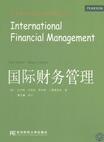国际财务管理
出版时间:2012-2 出版社:东北财经大学出版社有限责任公司 作者:(美)贝克特,(美)霍德里克 著,曹玉珊 译注 译者:曹玉珊
Tag标签:无
内容概要
本书赋予企业领导者在全球竞争环境下获得成功的工具。这部苫吉尔特·贝克特和罗伯特·J·霍德里克所著的教材,从全球化的视野出发,理论与实践并举,广泛的数据分析、观点各异的课堂讨论、著名跨国企业的案例让学生真正地理解当面临国际财务决策时要做什么以及为什么所做的决策是正确的。
作者简介
吉尔特·贝克特(Geert
Bekaert)是哥伦比亚商学院金融与经济系的利昂·G.库珀曼(Leon
G.Cooperman)讲席教授,同时是国家经济研究局的研究副主任。他获得了伊利诺伊州西北大学经济系博士学位,在哥伦比亚商学院从事投资与财管理等课程的教学。贝克特也曾担任斯坦福大学商学研究生院的财务学副教授。他的研究方向主要是国际融资,尤其侧重外汇市场效率及全球权益市场价值评估。另外,贝克特是Pani
Bekaert Pluim有限责任公司的管理人员和研究主管。该公司是瞄准于全球市场的私人投资公司,为Financial
Engines公司提供咨询服务,并为个人投资者提供个性化的投资建议。贝克特住在纽约和比利时,喜欢打篮球、壁球,听风格另类的歌曲。
罗伯特·J.霍德里克(Robert
J.Hodrick)是哥伦比亚商学院国际财务系自9Nomura教授,同时也是国家经济研究局的研究副主任,获得芝加哥大学博士学位。在去哥伦比亚商学院之前,他曾在卡内基‘梅隆大学及西北大学J.L.凯洛格管理研究生院任职。霍德里克目前从事国际财务基础课程与高级课程的教学工作。他的专业在金融资产估价方面尤为突出。他最近的研究探究了理论定价模型的经验结论,这一结论认为市场上债券、权益工具及外币将产生随时间变化的风险溢价。霍德里克住在纽约的斯卡斯代尔,喜欢长途单车旅行。
书籍目录
第1篇 外汇市场及其风险导论
第1章 全球化与跨国公司
第2章 外汇市场
第3章 远期市场及其交易兑换风险
第4章 国际收支平衡
第5章 汇率制度
第2篇 国际平价条件与汇率决定
第6章 利率平价
第7章 外汇市场的投机与风险
第8章 购买力平价与实际汇率
第9章 实际汇率风险的计量与管理
第10章 汇率的决定与预测
第3篇 国际资本市场
第11章 国际负债融资
第12章 国际权益融资
第13章 国际资本市场均衡
第14章 政治风险与国家风险
第4篇 国际公司融资
第15章 国际资本预算
第16章 国际资本预算的补充话题
第17章 风险管理与外币套期保值决策
第5篇 持续经营管理
第18章 国际贸易融资
第19章 净营运资本管理
第6篇 外币衍生品
第20章 外汇期货与外汇期权
第21章 利率与外汇互换
术语表(中文)
术语表(英文)
章节摘录
版权页: 插图: Chapfer 1 Globalization and the Multinational Corporation 1.1 INTRODUCTION The world economy is becoming increasingly globalized.Look around you, and you will see students from many different countries. The pen you use to take notes may have been made in China, the chips in your laptop computer may have come from Korea, and its software could have been developed by Indian engineers. We hope that during your study break, you savor some Italian espresso, although the "Italian" coffee beans that were roasted in Italy were likely grown in Indonesia or Brazil. The concept of globalization refers to the increasing connectivity and integration of countries and corporations and the people within them in terms of their economic, political, and social activities. Because of globalization, multinational corporations are dominating the corporate landscape. A multinational corporation (MNC) is a company that produces and sells goods or services in more than one nation. A prototypical example is the Coca-Cola Company, which operates in more than 200 countries. It is also likely that a multinational corporation is producing your favorite brew. For example, InBev is a publicly traded company headquartered in Belgium, which until recently was a family-controlled finn with origins dating back to 1366. Over time, the local Belgian firm grew into a large multinational corporation called Interbrew, with famous brands such as Stella Artois and Leffe. In 2004, Interbrew and Companhia de Bebidas das Américas (AmBev), from Brazil, merged to create InBev, which is now the world's largest brewer by volume. In 2004, InBev sold 202 million hectoliters (hl) of beer and 31.5 million hl of soft drinks. The link between a large European company and a large company from an emerging economy is no coincidence. One of the major trends in recent years has been the strong growth of Brazil, Russia, India, and China (sometimes referred to as BRIC). Today, BRIC accounts for two-fifths of the gross domestic product (GDP) of all emerging countries. The integration of these emerging economies into the global economy was forcefully illustrated in 2006, with the creation of the world's largest steel company. Mittal Steel, an Indian company, took over the European steel producer Arcelor, which was created by an earlier merger of steel companies in France, Belgium, uxembourg, and Spain. The fact that Arcelor's management at first opposed the takeover shows that globalization does not necessarily proceed smoothly.
编辑推荐
《高等院校双语教学适用教材•会计:国际财务管理》赋予企业领导者在全球竞争环境下获得成功的工具。由东北财经大学出版社出版。
图书封面
图书标签Tags
无
评论、评分、阅读与下载
用户评论 (总计1条)
- 我买了书后发现选修课选错了退了课书还是很好的,有时间再看。。
